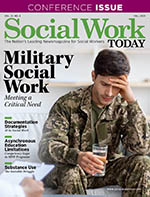|
Fall 2025 Issue Asynchronous Education Limitations Competency Gaps and the Need for Real-World Preparedness in MSW Programs The rise of online education has significantly changed the learning landscape, especially in fields like social work, where interpersonal skills and practical experience are essential. An MSW degree is crucial for equipping individuals with the knowledge and skills needed to address complex social issues. Asynchronous education, which allows for flexibility and self-paced learning, has become increasingly popular in terminal MSW programs.1 While this format offers many advantages, such as accommodating diverse schedules, reducing geographic barriers, and enhancing accessibility, it also presents several drawbacks that can hinder the development of vital competencies in social work education.2 Specifically, the limitations of asynchronous courses can impact students’ preparedness for real-world social work practice. This article explores the challenges of asynchronous courses in the context of social work and examines the competency gaps that can arise, emphasizing the need for real-world preparedness in social work. It also proposes strategies for improving this mode of learning. Limitations of Asynchronous Programs According to Fabriz et al, traditional in-person classroom environments facilitate immediate interaction; students can actively participate in discussions, pose questions, and receive instant feedback from instructors and peers.3 This dynamic creates an enriching learning atmosphere, where ideas can be exchanged freely, and misunderstandings can be promptly addressed. In contrast, asynchronous formats often inhibit this level of engagement. According to Wang & Woo,4 students may struggle with clarifying doubts and miss out on opportunities for collaborative learning. The absence of real-time conversations can lead to a disconnection from the material, as students may feel isolated in their learning experience. Additionally, the delay in communication can hinder the development of critical skills such as active listening and conflict resolution, which are essential in social work practice.4 The concept of reduced peer collaboration through real-time class discussions is particularly significant within the realm of social work education, which traditionally places a strong emphasis on the importance of teamwork and effective collaboration.4 According to this research, practitioners in the field of social work often find themselves engaged in multidisciplinary teams, where the ability to work cohesively with colleagues from various professional backgrounds is essential for delivering comprehensive care and support to clients. However, the shift towards asynchronous courses can pose challenges to fostering essential collaborative learning experiences.4 In these settings, students may have limited opportunities to engage in dynamic group discussions, which are vital for exchanging diverse perspectives and critically analyzing different viewpoints. The absence of real-time interaction can hinder the development of critical thinking skills, as students may not be prompted to articulate their thoughts or challenge one another’s assumptions in the same way they would in a more interactive environment.3 Moreover, without regular peer feedback, students may overlook valuable insights that could enhance their understanding of complex social issues and the intricacies of human behavior. This lack of collaborative engagement can lead to a gap in students’ experiential learning, such as interpersonal skills, ultimately affecting their ability to cultivate the collaborative skills that are necessary for effective practice in the field.3 Additionally, the inherently solitary nature of asynchronous learning environments can significantly contribute to feelings of isolation among students.5 In fields such as social work, where building relationships and fostering meaningful connections with clients and colleagues is essential, this disconnection can pose serious challenges. Students engaged in asynchronous courses may find themselves lacking the opportunities for real-time interaction and collaborative learning that traditional classroom settings provide.5 As a result, these learners may struggle to develop their interpersonal skills, the competencies they will be expected to utilize in their professional roles. The absence of immediate feedback and peer engagement can exacerbate feelings of loneliness, making it difficult for students to maintain their motivation and engagement in the coursework.6 Social work education places a strong emphasis on the importance of hands-on experiences and the practical application of theoretical concepts. This is often achieved through various methods such as fieldwork, role-playing exercises, and simulations, which allow students to engage with real-world situations and develop their skills in a supportive environment. While some asynchronous courses may attempt to incorporate virtual simulations or case studies into their curriculum, these alternatives often fall short of providing the rich, interactive learning environment that is found in traditional settings.7 According to this research, the absence of real-time feedback and immediate interaction with instructors can significantly diminish the overall learning experience. In particular, students may find it challenging to effectively translate their theoretical knowledge into practical skills when they do not have access to the guidance and expertise of experienced practitioners.7 This lack of direct mentorship can create a disconnect between what students learn in the classroom and how those principles apply to actual social work scenarios, ultimately impacting their confidence and ability to perform in real-life situations.1 Therefore, a well-rounded social work education should prioritize avenues for direct, experiential learning alongside theoretical instruction through interpersonal scenarios that could be completed through virtual reality exercises. Strengthening Asynchronous MSW Programs Encouraging peer collaboration is another critical strategy for enhancing engagement in asynchronous courses.9 By designing these mandatory structured opportunities for collaborative work, such as group projects, online live discussion forums, and peer-reviewed assignments, students can interact with one another in meaningful ways. These collaborative assignments mirror the teamwork required in social work practice, helping students to develop essential communication and interpersonal skills. Utilizing technology platforms that promote collaboration, such as breakout rooms during video calls, allows students to engage in small group discussions or work together on case studies. Additionally, implementing peer mentoring programs can further enrich the learning experience by fostering a supportive network among students, wherein they can share insights, provide constructive feedback, and motivate each other to excel in their studies.9 Regular check-ins with instructors or mentors are another vital component of these support systems. By maintaining open lines of communication, instructors can monitor student engagement and motivation levels. This proactive approach can help identify struggling students early on, allowing for timely interventions to keep them on track academically.10 Furthermore, integrating experiential learning opportunities is crucial for bridging the gap between theory and practice. According to Alabi,11 this can involve the use of virtual simulations that mimic real-world scenarios, case studies that require critical thinking and problem-solving, and role-playing exercises that enhance communication skills. Virtual simulation can be used for real-life scenarios that mimic the time of interaction one would spend with a client. By actively engaging in these learning activities, students can apply theoretical concepts in a practical context, deepening their understanding and boosting their confidence in handling real-world situations. Providing constructive feedback on these experiential learning activities is also important, as it fosters reflective learning and continuous improvement.11 To effectively engage students and accommodate various learning styles, it is essential to implement a wide array of instructional methods. Utilizing multimedia presentations, such as videos, animations, and infographics, can make complex concepts more accessible and engaging.11 Additionally, incorporating interactive quizzes allows students to actively participate in their learning process, reinforcing their understanding of the material through gamified assessments. These quizzes could be embedded into online lectures so that, as students listen to the lecture, periodic questions will be asked on the content throughout, reinforcing the learning process. Establishing a sense of community within the classroom is crucial for reducing feelings of isolation, especially in online or hybrid learning environments.12 According to the research, creating online discussion boards where students can pose questions, share resources, and engage in meaningful conversations promotes collaboration and peer support. Social media groups tailored to course topics can serve as informal spaces for discussion, allowing students to connect and share experiences in a more relaxed setting. By prioritizing community-building activities, educators can enhance the overall learning experience and create a more inclusive classroom atmosphere.12 Conclusion Moreover, the absence of adequate experiential learning opportunities can further impede students’ readiness to face real-world scenarios.4 Social work is inherently a relational profession, relying heavily on establishing and maintaining effective relationships with clients, colleagues, and communities. The digital divide in asynchronous formats can make it difficult for students to gain the hands-on experience necessary to fully understand the dynamics of social work environments. Additionally, many students may experience feelings of isolation when participating in asynchronous courses, which can negatively impact their motivation and overall learning experience. This isolation can diminish the sense of belonging and teamwork that are vital components of social work education and practice. To mitigate these issues, it is essential for MSW programs to incorporate more synchronous elements, such as live discussions, workshops, and collaborative projects, that facilitate real-time communication and interaction. Real-world experiences, such as internships and field placements, should also be prioritized within the curriculum. According to Fabriz,3 by creating opportunities for students to apply theoretical knowledge in practical settings, programs can better equip them to navigate the complexities and ethical dilemmas they will encounter within the profession. Emphasizing skills development through direct engagement and fostering a strong sense of community will not only enhance students’ learning experiences but also prepare them to meet the diverse demands of their future roles as social workers.4 In conclusion, by addressing these limitations inherent in asynchronous education, social work programs can improve their alignment with the ethical standards and competencies necessary for effective practice. Such efforts will ultimately contribute to enhanced outcomes for clients and the communities they serve, reinforcing the vital role of well-prepared social workers in society. — Gariy Livshits, DSW, LCSW, is a social work leader with over 25 years of experience in public mental health, creative arts therapy, and education. He serves as Director of Forensic Intensive Case Management Services at the New York State Office of Mental Health and teaches social work at Columbia University, Syracuse University, Ohio University, and the University of Kentucky. With advanced degrees in music therapy and social work, Livshits is passionate about innovative teaching and preparing the next generation of social work professionals.
References 2. Ravizza SM, Meram NL, Hambrick DZ. Synchronous or asynchronous learning: personality and online course format. Personality and Individual Differences. 2023; 207;112149. 3. Fabriz S, Mendzheritskaya J, Stehle S. Impact of synchronous and asynchronous settings of online teaching and learning in higher education on students' learning experience during covid-19. Frontiers in Psychology. 2021;12. 4. Wang Q, Woo H. Comparing asynchronous online discussions and face‐to‐face discussions in a classroom setting. British Journal of Educational Technology. 2006;38(2):272-286. 5. Alsayer, AA. Learners' experiences in an online learning environment: An analysis of the impact of international collaboration. Sage Open. 2023;13(4). 6. Richardson JC, Swan K. Examining social presence in online courses in relation to students' perceived learning and satisfaction. Online Learning. 2019; 7(1). 7. Valiente-Riedl E, Anderson L, Banki S. Practicing what we teach: experiential learning in higher education that cuts both ways. Review of Education, Pedagogy, and Cultural Studies. 2021;44(3): 231-252. 8. Moffat J. Creating an engaging asynchronous online learning environment. Use Bubbles website. https://www.usebubbles.com/blog/creating-an-engaging-asynchronous-online-learning-environment?utm_medium=organic&utm_source=w. Published November 28, 2023. 9. Dogbey J, Kumi-Yeboah A, Dogbey J. Dialogue pedagogical strategies perceived to enhance online interaction. International Journal of Online Pedagogy and Course Design. 2017; 7(3):70-85. 10. Sweetman DS. Making virtual learning engaging and interactive. FASEB BioAdvances. 2020;3(1):11-19. 11. Alabi M. Experiential learning: fostering deep learning through active engagement. Research Gate. 2024. 12. Covelli BJ. Online discussion boards: the practice of building community for adult learners. The Journal of Continuing Higher Education. 2017; 65(2):139-145. |


